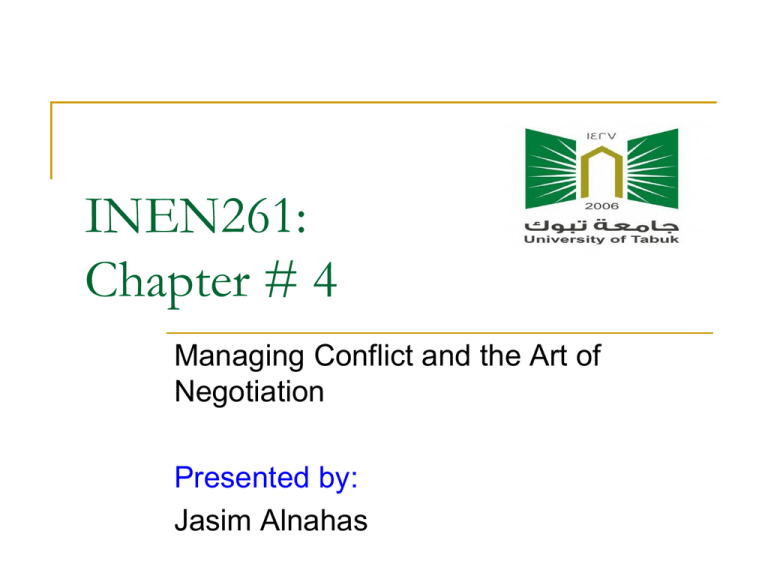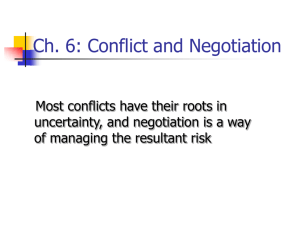Conflict
advertisement

INEN261: Chapter # 4 Managing Conflict and the Art of Negotiation Presented by: Jasim Alnahas Chapter Learning Outcomes If you complete the given assignments for this chapter you will: 4-2 Understand the nature of conflicts Understand the role of negotiations in conflicts Conflict 4-3 Conflict: the process which begins when one party perceives that the other has frustrated some concern of his Our concern is goal conflicts that occur when a group pursues goals different from other groups Source: Meridith, J.R., and Mantel, S.K. Jr., Project Management, A Managerial Approach, Eight Edition, Wiley & Sons Inc., 2012 Conflict typically has a negative connotation 4-4 “One party perceives that the other has frustrated, or is about to frustrate some concern of his.” Conflict is resolved when the level of frustration is lowered to the point where no action against the other party is contemplated Negotiation is a process for resolving that conflict Conflict however can be a positive force in Projects 4-5 Conflict can improve the planning process by adding creativity Debate (conflict) over the proper technical approach to a problem often generates a collaborative solution that is superior to any solution originally proposed Conflict often educates individuals and groups about the goals/objectives of other individuals and groups The positive resolution of the conflict can be a teambuilding process Conflict and the Project Life Cycle 4-6 Certain patterns of conflict are associated with the different periods in the life of a project Project formation Project build up Main program Project phase-out Conflict appears to fall into three fundamentally different categories: 1. Groups working on the project may have different goals and expectations 2. There is considerable uncertainty about who has the authority to make decisions 3. There are interpersonal conflicts between people who are parties-at-interest (Project Team, Client, Functional Management) in the project Conflict During Project Formation 4-7 In the initial stage of the project life cycle, most of the conflict centers around the inherent confusion of setting up a project At this point, almost nothing about the project or its governance has been decided Moving from this chaotic environment to the buildup stage can be difficult Resolving Conflict During Project Formation (The Plan resolves Conflict!) 4-8 To make the transition from project formation to buildup, four fundamental issues must be addressed: The technical objectives of the project must be specified to a degree that will allow the detailed planning of the build up stage to be accomplished Commitment of resources to the project must be forthcoming from senior management and functional managers The priority of the project relative to the priorities of the parent organization’s other projects, must be set and communicated The organizational structure of the project must be established to an extent sufficient for the action plan, WBS and linear responsibility chart to be prepared What types of conflict are we resolving? 4-9 We are eliminating uncertainty in decision making and other areas We are attempting to align goals and expectations Conflict During Project Build-Up 4-10 This is the period during which the project moves from a general concept to a highly detailed set of plans As the plans become detailed, conflicts over technical issues build Conflicts between the project manager and the functional areas tend to predominate Usually, the functional areas can claim more technical expertise than the project manager who is a “generalist” Conflict During a Project’s Main Program 4-11 Schedules are still a major source of conflict in the main program “Catching up” requires extra resources that the functional groups will demand, but which the project manager may not have. Functional managers will have to borrow from other projects or delay your project Technical conflicts are frequent and serious during the main program stage More Conflict During a Project’s Main Program 4-12 During this phase of the project the many parts must be linked properly These linkages are known as interfaces The number of interfaces increases rapidly as the project gets larger, which is to say that the system gets more complex The need to manage these interfaces and correct incompatibilities is the key to the technical conflicts in the main program phase Conflict During Project Phase Out 4-13 Schedule is the major source of conflict during project phaseout Technical problems are comparatively rare because most have been solved or bypassed Personality conflicts are the second ranked source of conflict during phaseout These conflicts can be caused by pressure to complete the project and to the anxiety about leaving the project The primary tool to accomplish conflict resolution and reduction is negotiation Conflict source by Project Phase (From Figure 6-1) Formation 1. 2. 3. 1. 2. 3. 4-14 Priorities Procedures Schedules Build-Up Priorities Schedule Procedures Main Program 1. 2. 3. Schedules Technical Labor Phase Out 1. 2. 3. Schedules Labor Personalities Conflict During a Project Few of the conflicts arising in projects have to do with whether or not a task will be undertaken Instead, they have to do with 4-15 The precise design of the deliverable How the design will be achieved By whom and at what cost Clear scopes of work define the tasks and communicate them sufficiently Conflict Resolution One requirement for conflict reduction/resolution by the project manager is that they must enable conflict to be settled without irreparable harm to the project’s objectives To do this, the project manager must: Allow (and foster) honesty between the negotiators Employ only ethical tactics during the negotiation Understand that any behavior that breeds mistrust will make future negotiations difficult, perhaps impossible Emphasize that the conflicting parties-at-interest are not enemies but rather allies - members of an alliance with strong common interests Work toward a win – win not a win - lose 4-16 Conflict Resolution A technique called “principled negotiation” tends to maintain these requirements of negotiation and is defined by four points: 1. 2. 3. 4. 4-17 Separate the people from the problem Focus on interests, not positions Before trying to reach an agreement, invent options for mutual gain Insist on using objective criteria Many other negotiations guidelines and models The Nature of Negotiation 4-18 The favored technique for resolving conflict is negotiation Negotiation is “the process through which two or more parties seek an acceptable rate of exchange for items they own or control” (If you are buying or selling) Negotiation “focuses on gaining the favor of people from whom we want things” Project team should view conflicts within the organization as conflicts between allies, not opponents Seek “win – win” resolution Projects require that activities be integrated across the functional borders of organizations 4-19 Project Managers are usually attempting to work across these functional borders Because each area has its own goals, integrating activities of two or more units (as projects do) is certain to produce conflicts These conflicts may be resolved by negotiating a solution, if one exists, that produces gains (or minimizes losses) for all parties with some degree of equity Negotiating a Resolution 4-20 Approaching project conflicts with a desire to win a victory over the other parties is inappropriate. The project manager should remember that he will be negotiating with project stakeholders many times in the future The proper objective should be to optimize the outcome in terms of overall organizational goals Let’s discuss – Negotiating Skills and Behaviors 4-21 Analyze the situation Differentiate between wants and needs (theirs and yours) Focus on interests and issues rather than positions Ask high, offer low but be realistic When you concede, act as though it is on something of value Seek a win – win. Don’t end with either party feeling they were taken advantage of. Listen well and articulate clearly Chapter Summary 4-22 Conflict is bound to occur on any project Often conflict will bring about improvement to the project execution Resolving the conflict rests largely with the project manager How well he resolves it is a key indicator of his effectiveness. He resolves it through negotiations Win-win negotiations should be the goal





